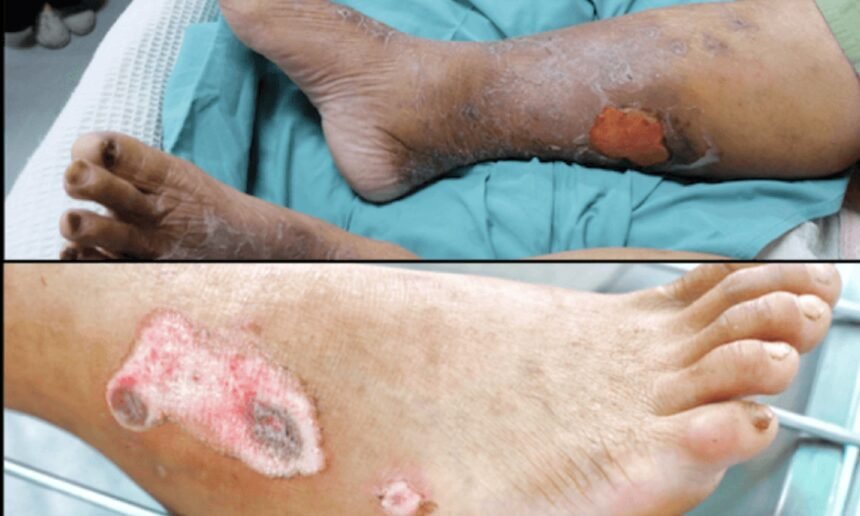Ulcers on the lower extremities are a common concern, especially for individuals with circulation issues. Among them, arterial ulcers and venous ulcers are two distinct types that require different approaches for diagnosis, treatment, and prevention. Understanding the key differences between arterial and venous ulcers is crucial for effective management and improved patient outcomes. This blog explores their causes, symptoms, diagnosis, and treatment options to help you distinguish between the two.
What Are Arterial and Venous Ulcers?
Arterial Ulcers
Arterial ulcers, also known as ischemic ulcers, result from poor blood supply due to blocked or narrowed arteries, often caused by peripheral artery disease (PAD). These ulcers typically develop on the toes, feet, and lower legs where circulation is compromised.
These ulcers are painful and may indicate underlying circulatory problems. For a deeper look into their symptoms and treatment, check out our arterial ulcer symptoms and treatment guide.
Venous Ulcers
Venous ulcers, also called stasis ulcers, are caused by chronic venous insufficiency (CVI), where faulty vein valves prevent proper blood flow back to the heart. These ulcers commonly occur on the lower legs, especially around the ankles.
Causes of Arterial vs. Venous Ulcers
Causes of Arterial Ulcers
- Peripheral artery disease (PAD) – Narrowed arteries reduce oxygen supply.
- Atherosclerosis – Plaque buildup restricts blood flow.
- Diabetes – Increases risk due to poor circulation.
- Smoking – Damages blood vessels, reducing oxygen to tissues.
- Hypertension (High Blood Pressure) – Causes arterial damage.
Causes of Venous Ulcers
- Chronic venous insufficiency (CVI) – Poor venous return leads to blood pooling.
- Deep vein thrombosis (DVT) – Blood clots can damage veins.
- Obesity – Increases venous pressure.
- Sedentary lifestyle – Reduces circulation and vein efficiency.
- Prolonged standing or sitting – Increases pressure in leg veins.
Symptoms: How to Identify the Difference
Symptoms of Arterial Ulcers
- Location: Toes, feet, heels, or lower legs.
- Appearance: Punched-out, well-defined edges, dry and necrotic wound bed.
- Pain: Severe, worsens at night or with elevation.
- Skin Changes: Cold, pale, or shiny skin around the ulcer.
- Poor Circulation: Weak or absent pulses in affected limb.
Symptoms of Venous Ulcers
- Location: Inner lower legs, near the ankles.
- Appearance: Shallow, irregular shape, moist wound bed with yellowish exudate.
- Pain: Mild to moderate, relieved by elevation.
- Skin Changes: Swollen, reddish-brown pigmentation, thickened skin.
- Venous Insufficiency Signs: Varicose veins, swelling, and heaviness in legs.
Diagnosis and Medical Evaluation
A healthcare provider will diagnose arterial and venous ulcers using:
- Physical examination to assess wound characteristics.
- Ankle-brachial index (ABI) to measure arterial blood flow.
- Doppler ultrasound to evaluate venous function.
- Blood tests to check for diabetes and lipid levels.
Treatment Options for Arterial and Venous Ulcers
Arterial Ulcer Treatment
- Revascularization procedures (angioplasty, bypass surgery) to restore blood flow.
- Medications: Blood thinners, cholesterol-lowering drugs, and antihypertensives.
- Wound care: Dry dressings, debridement, and infection control.
- Lifestyle changes: Smoking cessation, regular exercise, and a healthy diet.
Venous Ulcer Treatment
- Compression therapy: Improves blood return and reduces swelling.
- Medications: Antibiotics for infections, diuretics for swelling control.
- Wound management: Moist dressings, debridement, and elevation of the legs.
- Surgical interventions: Vein ablation, vein stripping, or sclerotherapy for severe cases.
Prevention Strategies
Preventing Arterial Ulcers
- Maintain a healthy diet rich in antioxidants and healthy fats.
- Engage in regular physical activity to improve circulation.
- Control diabetes, high blood pressure, and cholesterol.
- Quit smoking to prevent further arterial damage.
Preventing Venous Ulcers
- Use compression stockings to support vein function.
- Avoid prolonged sitting or standing and take movement breaks.
- Elevate legs to promote venous return.
- Maintain a healthy weight to reduce vein pressure.
Preventing these ulcers involves understanding and managing specific lifestyle and health risks. Learn about risk reduction strategies for arterial ulcers to protect yourself or loved ones from complications.
Conclusion
Understanding the differences between arterial and venous ulcers is crucial for proper diagnosis and effective treatment. While arterial ulcers stem from poor circulation due to blocked arteries, venous ulcers result from faulty vein function and blood pooling. Early intervention, lifestyle changes, and proper medical care can significantly improve healing outcomes and prevent complications.


Leave a Reply